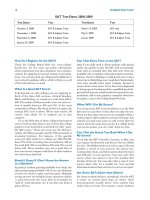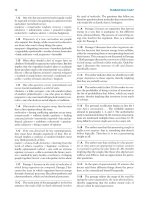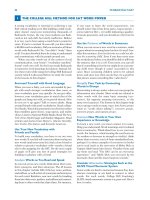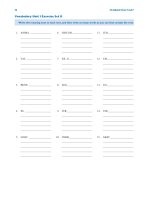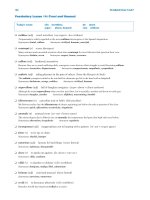Sat - MC Grawhill part 69 pps
Bạn đang xem bản rút gọn của tài liệu. Xem và tải ngay bản đầy đủ của tài liệu tại đây (211.85 KB, 10 trang )
670 McGRAW-HILL’S SAT
6 6 666 6
31. Which of the following is the best way to com-
bine sentences 3, 4, and 5?
(A) The name of the phenomenon comes
from the legend of Archimedes, who had
been thinking for days about how to
determine whether King Hieron II’s crown
was pure gold without destroying it.
(B) Archimedes had been thinking for days
about how to determine whether King
Hieron II’s crown was pure gold without
destroying it, and this is where the name
of the phenomenon comes from.
(C) The legend of Archimedes thinking
about how to determine whether King
Hieron II’s crown was pure gold without
destroying it is the origin of the name of
the phenomenon.
(D) The phenomenon is named for
Archimedes and his thinking for days
about how to determine whether King
Hieron II’s crown was pure gold without
destroying it.
(E) The name of the phenomenon was from
Archimedes, and his thinking for days
about how to determine without destroy-
ing it whether King Hieron II’s crown
was pure gold.
32. Which of the following revisions of sentence 7
most clearly and logically introduces the sec-
ond paragraph?
(A) This historical episode is something that
all students should learn about in school.
(B) Understanding this phenomenon may
help students to improve their studies.
(C) Nevertheless, this episode is something
that all students should know.
(D) Understanding this episode requires a
more thorough understanding of its
historical setting.
(E) Many have tried to understand this
phenomenon, but few have succeeded.
33. Which of the following is the best revision of
the underlined portion of sentence 8 (repro-
duced below)?
You have probably had the experience of think-
ing about a paper or a math problem for so long
that it’s like one’s brain gets frozen
.
(A) it seems that your brain gets frozen
(B) one’s brain gets frozen
(C) your brain seems to freeze
(D) your brains seem to freeze
(E) one’s brain seems to freeze
34. Where is the best place to insert the following
sentence?
Perhaps if students could work such little excur-
sions into their busy study schedules, they
would have similar “eureka” experiences.
(A) after sentence 7
(B) after sentence 8
(C) after sentence 9
(D) after sentence 10
(E) after sentence 11 (as the last sentence of
the second paragraph)
35. In context, which of the following revisions of
the underlined portion of sentence 12 (repro-
duced below) is most effective at making it
clearer and more specific?
Unfortunately, many students today don’t have
time for that.
(A) today have hardly even 1 hour for such
things
(B) today, unlike those in Archimedes’ time,
don’t have time to go to the movies
(C) today don’t have time for such excursions
(D) of modern times lack sufficient time for
the kinds of things explained above
(E) today lack sufficient time for things like this
STOP
If you finish before time is called, you may
check your work on this section only. Do not
turn to any other section of the test.
CHAPTER 16 / PRACTICE TEST 2 671
7 7 777 7
GO ON TO THE NEXT PAGE
1. If four apples cost 20 cents, then, at this rate,
how much would ten apples cost?
(A) $.40
(B) $.50
(C) $.60
(D) $.70
(E) $.80
2. If 2
b
= 8, then 3
b
=
(A) 6
(B) 9
(C) 27
(D) 64
(E) 81
3. How much greater is the average (arithmetic
mean) of a, b, and 18 than the average of a, b,
and 12?
(A) 2
(B) 3
(C) 4
(D) 5
(E) 6
SECTION 7
Time—20 minutes
16 questions
Turn to Section 7 of your answer sheet to answer the questions in this section.
Directions: For this section, solve each problem and decide which is the best of the choices given. Fill in
the corresponding circle on the answer sheet. You may use any available space for scratchwork.
1. The use of a calculator is permitted.
2. All numbers used are real numbers.
3. Figures that accompany problems in this test are intended to provide information useful in solv-
ing the problems. They are drawn as accurately as possible EXCEPT when it is stated in a spe-
cific problem that the figure is not drawn to scale. All figures lie in a plane unless otherwise
indicated.
4. Unless otherwise specified, the domain of any function f is assumed to be the set of all real num-
bers x for which f(x) is a real number.
The number of degrees of arc in a circle is 360.
The sum of the measures in degrees of the angles of a triangle is 180.
NotesReference Information
r
A = πr
2
C=2πr
ᐉ
w
A =
ᐉw V = ᐉwh V = πr
2
h
Special right triangles
c
2
= a
2
+ b
2
A =
1
/
2
bh
h
b
ᐉ
w
h
r
h
b
c
a
2x
x
x
s
s
s
3
2
30°
60°
45°
45°
672 McGRAW-HILL’S SAT
7 7 777 7
GO ON TO THE NEXT PAGE
4. The first day of a particular month is a Tuesday.
What day of the week will it be on the 31st day
of the month?
(A) Wednesday
(B) Thursday
(C) Friday
(D) Saturday
(E) Sunday
5. How many integer pairs (m, n) satisfy the
statements 0 < m + n < 50 and ?
(A) 5
(B) 6
(C) 7
(D) 8
(E) more than 8
6. If y% of 50 is 32, then what is 200% of y?
(A) 16
(B) 32
(C) 64
(D) 128
(E) 256
7. For x > 0, the function g(x) is defined by the
equation g(x) = x + x
1/2
. What is the value of
g(16)?
(A) 16
(B) 20
(C) 24
(D) 64
(E) 272
m
n
= 8
Note: Figure not drawn to scale.
8. In the figure above, if the slope of AB
—
is −
3
⁄
4
,
what is the area of ΔABO?
(A) 54
(B) 72
(C) 96
(D) 108
(E) 192
–1, 1, 2, −1, 1, 2, −1, 1, 2, . . .
9. The sequence above continues according to
the pattern shown. What is the sum of the
first 25 terms of this sequence?
(A) 15
(B) 16
(C) 18
(D) 19
(E) 21
10. A jar contains only white and blue marbles of
identical size and weight. The ratio of the
number of white marbles to the number of
blue marbles is 4 to b. If the probability of
choosing a white marble from the jar at ran-
dom is
1
⁄
4
, then what is the value of b?
(A) 1
(B) 2
(C) 6
(D) 12
(E) 16
O
x
y
A
12
B
CHAPTER 16 / PRACTICE TEST 2 673
7 7 777 7
11. The area of a right triangle is 10 square
centimeters. If the length of each leg, in cen-
timeters, is a positive integer, then what
is the least possible length, in centimeters, of
the hypotenuse?
(A)
(B)
(C)
(D)
(E)
12. If y is a number less than 0 but greater than −1,
which of the following expressions has the
greatest value?
(A) 100y
(B) y
2
(C) y
3
(D) y
4
(E) y
5
13. If at least one wuzzle is grumpy, then
some fuzzles are lumpy.
If the statement above is true, then which of
the following must also be true?
(A) If all wuzzles are grumpy, then all
fuzzles are lumpy.
(B) If no wuzzle is grumpy, then all
fuzzles are lumpy.
(C) If all fuzzles are lumpy, then all
wuzzles are grumpy.
(D) If no wuzzle is grumpy, then no fuzzle
is lumpy.
(E) If no fuzzle is lumpy, then no wuzzle is
grumpy.
401
104
101
41
29
14. Six buses are to carry 200 students on a field
trip. If each bus must have no more than
40 students and no fewer than 30 students,
then what is the greatest number of buses that
can have 40 students?
(A) 6
(B) 5
(C) 4
(D) 3
(E) 2
15. The volume of right cylinder A is twice the vol-
ume of right cylinder B. If the height of cylin-
der B is twice the height of cylinder A, then
what is the ratio of the radius of cylinder A to
the radius of cylinder B?
(A) 1 to 2
(B) 1 to 1
(C)
(D) 2 to 1
(E) 4 to 1
16. In a garden that is divided into x rows of
x squares each, w of the squares lie along the
boundary of the garden. Which of the follow-
ing is a possible value for w?
(A) 29
(B) 34
(C) 40
(D) 46
(E) 55
21to
STOP
If you finish before time is called, you may
check your work on this section only. Do not
turn to any other section of the test.
674 McGRAW-HILL’S SAT
8 8 888 8
GO ON TO THE NEXT PAGE
2. The concept that the Earth is round was
once theory, but is now accepted as an
inarguable truth.
(A) an incontrovertible
(B) a mellifluous
(C) an admirable
(D) a dubious
(E) an accurate
3. The controversy within the party produced
a that broke it into several factions even
before the matter could be fully discussed
among the members.
(A) unanimity
(B) schism
(C) caucus
(D) commemoration
(E) prognostication
4. Horace Mann, widely acknowledged as the fa-
ther of American public schooling, the
Massachusetts legislature to institute a system
for universal access to education.
(A) petitioned . . restricting
(B) established . . denying
(C) persuaded . . ensuring
(D) tolerated . . requiring
(E) discouraged . . vouchsafing
1. The evidence for ESP is at best, so very few
reputable scientists are willing to even that
the phenomenon exists.
(A) meager . . regret
(B) unconvincing . . suggest
(C) plentiful . . admit
(D) paltry . . deny
(E) strong . . assume
SECTION 8
Time—20 minutes
19 questions
Turn to Section 8 of your answer sheet to answer the questions in this section.
Directions: For each question in this section, select the best answer from among the choices given and
fill in the corresponding circle on the answer sheet.
Each sentence below has one or two blanks,
each blank indicating that something has been
omitted. Beneath the sentence are five words
or sets of words labeled A through E. Choose
the word or set of words that, when inserted
in the sentence, best
fits the meaning of the
sentence as a whole.
EXAMPLE:
Rather than accepting the theory unquestion-
ingly, Deborah regarded it with
.
(A) mirth
(B) sadness
(C) responsibility
(D) ignorance
(E) skepticism
A
C D
B
B
CHAPTER 16 / PRACTICE TEST 2 675
8 8 888 8
Questions 7–19 are based on the following passages.
The following two passages concern the use of
“reinforcers,” which are rewards or punish-
ments used to encourage desired behaviors, and
“contingencies,” which are the arrangements of
those reinforcers to shape behavior.
PASSAGE 1
“Avoid compulsion,” said Plato in The Republic,
“and let your children’s lessons take the form
of play.” Horace, among others, recom-
mended rewarding a child with cakes. Eras-
mus tells of an English gentleman who tried
to teach his son Greek and Latin without pun-
ishment. He taught the boy to use a bow and
arrow and set up targets in the shape of Greek
and Latin letters, rewarding each hit with a
cherry. He also fed the boy letters cut from
GO ON TO THE NEXT PAGE
5. The light from most stars takes millions of years
to reach us, so not only is the present existence
of these stars , but so are the very concepts
of “the present” and “existence.”
(A) debatable
(B) methodical
(C) indecorous
(D) imperious
(E) profuse
6. Although many parents prefer to be when
their children broach sensitive personal sub-
jects, others resort instead to so as to make
any potentially offensive matters seem less ob-
jectionable.
(A) honest . . anachronism
(B) intolerant . . laudation
(C) clandestine . . obligation
(D) candid . . euphemism
(E) forthright . . coercion
delicious biscuits. Privileges and favors are often
suggested, and the teacher may be personally
reinforcing as friend or entertainer. In indus-
trial education students are paid for learning.
Certain explicit contrived reinforcers, such as
marks, grades, and diplomas, are characteris-
tic of education as an institution. (These sug-
gest progress, but like progress they must be
made reinforcing for other reasons.) Prizes
are intrinsically reinforcing. Honors and
medals derive their power from prestige or
esteem. This varies between cultures and
epochs. In 1876 Oscar Wilde, then 22 years
old and halfway toward his B.A. at Oxford, got
a “first in Mods.” He wrote to a friend: “. . . I
did not know what I had got till the next
morning at 12 o’clock, breakfasting at the
Mitre, I read it in the Times. Altogether I
swaggered horribly but am really pleased with
myself. My poor mother is in great delight,
and I was overwhelmed with telegrams on
Thursday from everyone I knew.” The con-
temporary student graduating summa cum
laude is less widely acclaimed.
Although free of some of the by-products of
aversive control, positive reinforcers of this
sort are not without their problems. Many are
effective only in certain states of deprivation
which are not always easily arranged. Making
a student hungry in order to reinforce him
with food would raise personal issues which
are not entirely avoided with other kinds of
reinforcers. We cannot all get prizes, and if
some students get high grades, others must
get low.
But the main problem again is the contin-
gencies. Much of what the child is to do in
school does not have the form of play, with its
naturally reinforcing consequences, nor is
there any natural connection with food or a
passing grade or a medal. Such contingencies
must be arranged by the teacher, and the
arrangement is often defective. The boy men-
tioned by Erasmus may have salivated slightly
First passage: B. F. Skinner,
The Technology of Teaching,
© 1968 Prentice-Hall.
Second passage: © 2004 Christopher Black. All rights reserved.
Reprinted by permission of the author.
Line
5
10
15
20
25
30
35
40
45
50
The passages below are followed by questions
based on their content; questions following a
pair of related passages may also be based on
the relationship between the paired passages.
Answer the questions on the basis of what is
stated
or implied in the passage and in any
introductory material that may be provided.
676 McGRAW-HILL’S SAT
8 8 888 8
GO ON TO THE NEXT PAGE
upon seeing a Greek or Latin text, and he was
probably a better archer, but his knowledge of
Greek and Latin could not have been appre-
ciably improved. Grades are almost always
given long after the student has stopped be-
having as a student. We must know that such
contingencies are weak because we would
never use them to shape skilled behavior. In
industrial education pay is usually by the
hour—in other words, contingent mainly on
being present. Scholarships are contingent on
a general level of performance. All these con-
tingencies could no doubt be improved, but
there is probably good reason why they re-
main defective.
PASSAGE 2
Even if they don’t study it as a philosophi-
cal matter, all teachers must at some point
confront the issue of whether, when, and how
to punish or reward student behavior. Unless
a teacher is blessed with a class full of highly
motivated adult-pleasers, it is nearly impossi-
ble to avoid the need to nudge students in one
direction or another. Simple suggestion works
occasionally, but not frequently enough. Rea-
soning sometimes works, too, but explaining
the logical nuances of behavioral standards is
often time-consuming and too often falls on
deaf ears. So the practical question becomes:
the carrot or the stick?
Most educators and psychologists agree
that reward is always better than punishment,
but a small yet vocal group of psychologists
have maintained since the 1960s that reward
is often just as harmful as punishment, if not
more so. Their arguments are subtle but very
persuasive. Educators like Alfie Kohn and psy-
chologists like Edward Deci claim that careful
study has shown that the introduction of a re-
ward system, like gold stars on an attendance
sheet or extra recess time for good behavior,
changes the nature of the desired behavior
completely, and not for the better. For in-
stance, Deci conducted a study in which peo-
ple were given a puzzle to solve. Some were
given money as a “reward” for solving the
puzzle and others were simply asked to solve
the puzzle. Afterwards, both groups were left
alone but watched carefully. Those who had
been paid stopped playing, but those who had
not been paid continued. Deci concluded that
the subjects who were paid probably con-
strued the task as being manipulative: the ex-
perimenter was trying to get them to do
something through bribery. The unpaid sub-
jects, however, were more likely to see the
task as fun and worth doing for its own sake.
This study and many like it have profound
implications for the classroom. Several exper-
iments have demonstrated that “pay-to-read”
programs, where students are given money or
certificates to read books, have surprisingly
negative effects on literacy. Such programs
usually get kids to “read” a lot more books,
but their reading skills and, far more impor-
tantly, their love of reading decline. Such pro-
grams, research suggests, turn reading into a
performance rather than a fulfilling personal
experience. They encourage students to read
books only superficially and only to get the
reward. What is worse, like Deci’s puzzle-
solvers, the students don’t want to continue
reading after the payments stop. Books have
become only enrichment for the pocket, not
enrichment for the mind.
Of course, the human mind is an enor-
mously complex machine, and it would be a
mistake to use these few experiments to gen-
eralize that all rewards are bad. Certainly,
honest and mindful praise from a respected
teacher can do a great deal to encourage not
only good behavior but rigorous intellectual
curiosity. Parents and teachers, however, need
to be very aware of children’s need to feel in
control of themselves.
7. It can be inferred that the “English gentleman”
(line 5) believed that good teaching utilized
(A) punishment
(B) well-written books
(C) reward
(D) humor
(E) careful grading
55
60
65
70
75
80
85
90
95
100
105
110
115
120
125
130
135
CHAPTER 16 / PRACTICE TEST 2 677
8 8 888 8
GO ON TO THE NEXT PAGE
8. The parenthetical remark in lines 17–19 is
intended to caution educators against
(A) failing to make grades and diplomas
meaningful to students
(B) punishing students unnecessarily
(C) employing dull lessons
(D) emphasizing entertainment over rigor
(E) using rewards as reinforcers
9. Passage 1 indicates that “cultures and epochs”
(lines 22–23) vary in the ways that
(A) universities choose from among their ap-
plicants
(B) academic awards are effective as
motivators
(C) universities teach literature
(D) students are paid money for learning
(E) the media portray educational crises
10. The Wilde story in lines 23–32, “In 1876 . . .
everyone I knew,’ ” is intended to illustrate
(A) how the modern cultural perception of
academic honors differs from that of a
previous era
(B) a particularly effective teaching
strategy
(C) how a famous author used rewards to
teach his students
(D) the dangerous effects of using academic
rewards
(E) the point that Plato makes in the first
sentence
11. Passage 1 mentions which of the following as
“problems” (line 37) inherent in the use of
positive reinforcers in education?
I. difficulties in scheduling the rein-
forcers
II. limitations in the supply of rein-
forcers
III. the fact that rewards encourage only
superficial learning
(A) I only
(B) II only
(C) I and II only
(D) I and III only
(E) I, II, and III
12. In the final paragraph of Passage 1, the author
suggests that grades are problematic as re-
inforcers because they
(A) cannot be given to every student
(B) do not provide sensual gratification, as
food does
(C) are not publicized enough
(D) are not given immediately after the de-
sired behavior is exhibited
(E) are not as useful to the student as money
13. The sentence that begins on line 78, “Reason-
ing sometimes works . . . on deaf ears” is in-
tended to describe the interaction between
(A) those who promote the use of punish-
ments and those who oppose it
(B) educators and philosophers
(C) parents and teachers
(D) teachers and administrators
(E) teachers and students
14. In Passage 2, Alfie Kohn and Edward Deci
(lines 90–91) are mentioned as examples of
(A) teachers who use rewards as reinforcers
(B) experts who question the effectiveness of
rewards as reinforcers
(C) scientists on opposite sides of a debate
(D) educators who prefer negative re-
inforcers to positive reinforcers
(E) educators who advocate a careful sched-
ule of contingencies for students
678 McGRAW-HILL’S SAT
8 8 888 8
15. In saying that “the introduction of a reward
system . . . changes the nature of the desired
behavior” (lines 92–95), the author of Passage
2 indicates that
(A) many people object to the use of punish-
ments in school
(B) teachers find it difficult to find the right
kinds of rewards for student
performance
(C) experts disagree about the effects of
rewards on human behavior
(D) such systems tend to decrease student in-
terest in the activity for its own sake
(E) not enough study has been done on the
effectiveness of rewards in education
16. Deci’s conclusion about the experiment de-
scribed in Passage 2 (lines 96–110) assumes
that the subjects in the study
(A) are well educated
(B) are highly proficient at solving puzzles
(C) have not participated in reward systems
before
(D) can make inferences about the motives
of the experimenter
(E) have some teaching experience
17. The author of Passage 2 mentions that “the
human mind is an enormously complex ma-
chine” (lines 129–130) in order to suggest that
(A) a simplistic theory about the effective-
ness of rewards is unwise
(B) people cannot be easily fooled
(C) many learning disabilities require special
attention
(D) teachers often find it hard to teach
certain subjects
(E) Deci’s experiment was poorly
constructed
18. The description of the “problems” (line 37)
with positive reinforcers in Passage 1 would
most likely be regarded by Edward Deci as
(A) thorough and fair
(B) presumptuous and incomplete
(C) unfair to educators
(D) erroneous in concluding that the methods
of the “gentleman” were ineffective
(E) likely correct, but worthy of further
study
19. Which of the following assumptions is shared by
the authors of both passages?
(A) Rewards are ineffective as reinforcers of
behavior.
(B) Honors and grades are necessary ele-
ments of institutional education.
(C) Good teaching is always focused on play.
(D) Negative feedback is not an effective
teaching tool.
(E) If prizes are to be used in a classroom,
there must be enough for all students.
STOP
If you finish before time is called, you may
check your work on this section only. Do not
turn to any other section of the test.
CHAPTER 16 / PRACTICE TEST 2 679
9 9 999 9
GO ON TO THE NEXT PAGE
1. Choreographer Alvin Ailey’s works, whose
style is rooted in the techniques of modern
dance, jazz dance and ballet, draw upon African
American themes.
(A) Choreographer Alvin Ailey’s works,
whose style is rooted in the techniques of
modern dance, jazz dance and ballet,
draw upon African American themes.
(B) Alvin Ailey has a style of a choreographer
that is rooted in the techniques of modern
dance, jazz dance and ballet of which also
draws upon African American themes.
(C) The works of choreographer Alvin Ailey,
which draw upon African American themes,
have a style that is rooted in the techniques
of modern dance, jazz dance, and ballet.
(D) Choreographer Alvin Ailey’s works,
which have a style that is rooted in the
techniques of modern dance, jazz dance,
and ballet, drawing upon African
American themes.
(E) Alvin Ailey’s style, a choreographer, is
rooted in the techniques of modern dance
and jazz dance and ballet which also
draws upon African American themes.
SECTION 9
Time—10 minutes
14 questions
Turn to Section 9 of your answer sheet to answer the questions in this section.
Directions: For each question in this section, select the best answer from among the choices given and
fill in the corresponding circle on the answer sheet.
The following sentences test correctness and
effectiveness of expression. Part of each sen-
tence or the entire sentence is underlined;
beneath each sentence are five ways of phras-
ing the underlined material. Choice A repeats
the original phrasing; the other four choices
are different. If you think the original phrasing
produces a better sentence than any of the
alternatives, select choice A; if not, select one
of the other choices.
In making your selection, follow the require-
ments of standard written English; that is, pay
attention to grammar, choice of words, sentence
construction, and punctuation. Your selection
should result in the most effective sentence—
clear and precise, without awkwardness or
ambiguity.
EXAMPLE:
The children couldn’t hardly believe their eyes
.
(A) couldn’t hardly believe their eyes
(B) could hardly believe their eyes
(C) would not hardly believe their eyes
(D) couldn’t nearly believe their eyes
(E) couldn’t hardly believe his or her eyes
A
C D
E
B


